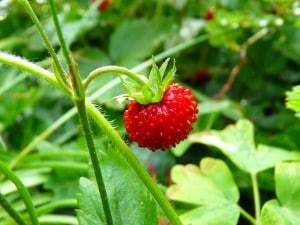 It’s the late spring when the plants perk up. You clear away the detritus of winter, give them a feed, begin to mulch. They lift up their heads, raise those perfect white and yellow flowers to look at the sky, those tiny heralds of the summer to come. School fetes, a lovers’ picnic, June breakfast on the doorstep, jam and buttered toast.
It’s the late spring when the plants perk up. You clear away the detritus of winter, give them a feed, begin to mulch. They lift up their heads, raise those perfect white and yellow flowers to look at the sky, those tiny heralds of the summer to come. School fetes, a lovers’ picnic, June breakfast on the doorstep, jam and buttered toast.
Soon, speckled green nubs appear, noses that push through pixie hat leaves. They arch over and turn down, swelling, widening at the base. They blush when they get big enough, if they can see the sun. The color enters through the umbilical stem, collects in the cone. That’s when the strawberries start to weigh the plant down, will touch the soil and bruise, soft brown patches spoiling their flesh. That’s when you’d better get some straw down, make a dry pillow to cushion the maturing fruit.
Mice and birds nibble little shallow hollows out, but their spit doesn’t spoil the flavour.
Each berry has its own perfect day, balanced on a fulcrum before tipping over, and it’s too late.
Some people say they don’t taste as good as they used to, that the berries are pampered, bloated, bred to produce a heavy crop. You can get the wild forest strawberries if you think that.
Longer, tighter, sharper colours and definitely sweeter, each berry is a highly charged thrill.
They make good ground cover as well, supressing weeds, doing your work for you. Their slim tendrils supplant anything. A word of warning, however: being essentially wild, unbiddable, they are apt to take over the border. They do not need the gardener.
They do not produce their fruit for you.
Tamsin Hopkins lives and writes in London. Her work has appeared in various anthologies, most recently Fiction Desk Ghost Stories II. Her story collection Sand Tranny and Other River Stories is due out in February of 2016 from Cinnamon Press. She tweets @TamsinHopkins and is working on a poetry collection.